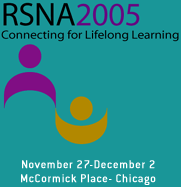
Abstract Archives of the RSNA, 2005
SSK03-06
Feasibility of Hepatic Arterial Therapy with Yttrium-90 Microspheres, SIR-SpheresŪ, in Metastatic Neuroendocrine Neoplasia with Hepatic Dominant Progression after Failure of Multiple Systemic and Hepatic Artery Therapies
Scientific Papers
Presented on November 30, 2005
Presented as part of SSK03: Vascular/Interventional (Oncologic Intervention)
Ravi Murthy MD, Presenter: Nothing to Disclose
Sanjay Gupta MD, Abstract Co-Author: Nothing to Disclose
David Craig Madoff MD, Abstract Co-Author: Nothing to Disclose
Rodolfo F. Nunez MD, Abstract Co-Author: Nothing to Disclose
James Yao, Abstract Co-Author: Nothing to Disclose
Janio Szklaruk PhD, MD, Abstract Co-Author: Nothing to Disclose
Kamran Ahrar MD, Abstract Co-Author: Nothing to Disclose
Michael J. Wallace MD, Abstract Co-Author: Nothing to Disclose
Steven McRae, Abstract Co-Author: Nothing to Disclose
Marshall E Hicks MD, Abstract Co-Author: Nothing to Disclose
et al, Abstract Co-Author: Nothing to Disclose
Neuroendocrine malignancies have a predilection for hepatic metastases. The development of unresectable hepatic neuroendocrine metastases (UHNM) has been traditionally managed with hepatic artery embolization/chemo-embolization (HAE/HACE). However following recurrence or development of new lesions, outcomes with repeat HAE/HACE yields diminishing results &/or enhanced toxicities. We present our experience with treatment feasibility of a relatively new hepatic arterial therapy, SIR-Spheres®, a 32μ resin sphere incorporating a pure Beta emitter Yttrium – 90, in this setting.
7 patients (2 well differentiated carcinoid, 4 well & 1 poorly differentiated islet cell tumor) with UHNM who were treated with 8 infusions of SIR-Spheres® after HAE/HACE met study criteria. Lobectomy with RFA in the hepatic remnant had been performed in 2 patients. All patients had at least one (range 1-6) previous HAE/HACE with SIR-Spheres® being administered as 4th-9th line therapy. The median interval from diagnosis to SIR-Spheres® treatment was 24 months (range 11-89 m) & from the last HAE/HACE was 6 months (range 1-11 m).
Pre therapy abdominal visceral arteriography with hepatic arterial injection of Tc 99m MAA demonstrated vasculature conducive for SIR-Spheres® delivery in all patients. Median hepatopulmonary shunt fraction was 6.8% (range 2 –14%). Five SIR-Sphere infusions were via the right & 3 via the left hepatic artery. The median dose of 40 mCi (range 24.9 – 55 mCi) was delivered with preservation of arterial patency. SPECT – CT fusion Bremsstrahlung scans post therapy confirmed preferential deposition of SIR-Spheres® within metastases including previously embolized sites. One patient had stable disease. 2 patients tolerated biologics following SIR-Spheres® treatment. No CTC Gr III hepatotoxicities were noted within 60 days in 6/7 patients. Median survival following diagnosis, & SIR-Spheres® therapy was 22 (range 16-34 m) & 5 months (range 1 – 26 m) respectively.
SIR-Spheres® preferentially deposits in metastases despite prior HAE/HACE and is feasible in a highly pretreated cohort of patients with UHNM.
R.M.: Proctor for SIRTEX Medical
Murthy, R,
Gupta, S,
Madoff, D,
Nunez, R,
Yao, J,
Szklaruk, J,
Ahrar, K,
Wallace, M,
McRae, S,
Hicks, M,
et al, ,
Feasibility of Hepatic Arterial Therapy with Yttrium-90 Microspheres, SIR-SpheresŪ, in Metastatic Neuroendocrine Neoplasia with Hepatic Dominant Progression after Failure of Multiple Systemic and Hepatic Artery Therapies. Radiological Society of North America 2005 Scientific Assembly and Annual Meeting, November 27 - December 2, 2005 ,Chicago IL.
http://archive.rsna.org/2005/4410064.html

